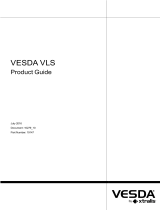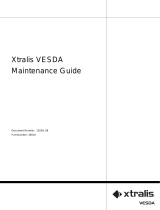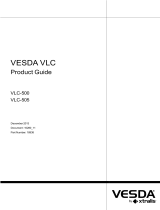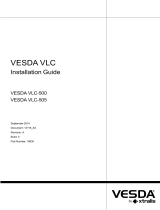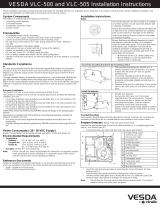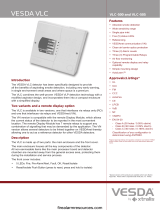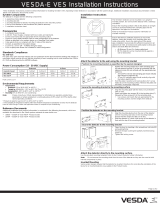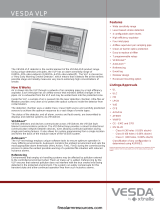Page is loading ...

System
Site
Guide
Your area is protected by a VESDA
Aspirating Smoke Detection System.
This system works by drawing air
through a network of pipes to a detector.
The air sample is then analyzed to
identify whether or not there is smoke in
the monitored area. If smoke is detected,
a reaction will be seen on the detector’s
display (if installed).
This leaet is a guide to how your
VESDA system works and explains the
system’ s basic functionality.
Bargraph Numerical Display
Alarm
Lights
Fault
Lights
Push
Butto
n
Keys
First
Alarm
Sector
Indicator
Threshold
Indicators
RESET
ISOLATE
FIRE
PRE-ALARM
OK
VESDA VLC
Alarm
Lights
Fault
Lights
Reset/Isolate
Button
FAULT
ResetSilence
ACTION
ALERT
Smoke Level
Zone Number
Sensitivity
FIRE
1
2
Isolated
OK
10
9
8
7
6
5
4
3
2
1
Mode
Test
Isolate
FAULTS
System
Zone
Urgent
Power
Network
Airflow
Filter
VESDA
®
VLP
Bargraph
Numerical Display
Alarm
Lights
Fault
Lights
Buttons
Threshold
Indicators
VESDA VLP
Display
This is the display typically found on a
VESDA VLP detector.
Push Button Keys:
Mode/Test (Dual Function) - Selects
modes on the numerical display i.e.,
sensitivity, smoke level, zone number.
When depressed for more than 2
seconds it will perform a light test.
Silence - Silences any alarm or fault
warnings. It stops the lights from
ashing to acknowledge a fault or alarm
condition.
Reset - Resets all the alarms and faults
on the detector. Any remaining alarms
or faults will be re-reported after time
delays have elapsed.
Isolate - Isolates the detector from any
external devices or systems (an isolate
alarm will normally be raised at the Fire
Alarm Control Panel).
VESDA VLC
Display
This is the display typically found on a
VESDA VLC detector.
Fire - The red light is illuminated when
the re alarm threshold is initiated.
Pre-Alarm/Alert - This red light is
permanently illuminated when the Pre-
Alarm threshold is initiated. The light
ashes when the Alert alarm threshold
is initiated (if congured).
Fault - Indicates a fault condition
OK - Indicates normal operation
Reset/Isolate (Dual Function) - When
pressed it resets all the alarms and faults
on the detector. When the button is
depressed for two seconds it isolates the
detector and raises a fault alarm.
IMPORTANT NOTE:
This document is for general
guidance only.
Your company’s re
procedures must take
precedence.
PLEASE NOTE: There
may be local variations
in equipment,
indications and
procedures.
VESDA VLS
Display
This is the display typically found on a
VESDA VLS detector.
Push Buttons Keys:
Mode/Test (Dual Function) - Selects
modes on the numerical display i.e.,
sensitivity, smoke level, zone number,
rst alarm sector. If depressed for more
than 2 seconds it will perform a light test.
Silence/Scan (Dual Function) -
Silences any alarm or fault warnings
and stops any lights from ashing.
When depressed for more than two
seconds the Scan function is activated.
The detector then scans each sector to
determine smoke levels.
Reset - Resets all the alarms and faults
on the detector. Any remaining alarms
or faults will be re-reported after time
delays have elapsed.
Isolate - Isolates the detector from any
external devices or systems (an isolate
alarm will normally be raised at the Fire
Alarm Control Panel).

FIRE 2
This alarm indicates an
EXTREMELY SERIOUS
situation and will most likely lead to
advanced re prevention procedures.
Automatic suppression systems may be
activated. Evacuation procedures will
also be initiated.
Contact your Fire Warden and follow the
instructions given to you.
Pipes and Sampling Points
The pipes and sampling points are
crucial to the operation of your VESDA
smoke detection system. They actively
transport air from the protected area to
the detector.
DO NOT cover, modify, paint or tamper
with any smoke detection system
sampling pipe or sampling point.
The following pictures show labels that
are typically used to identify the VESDA
system’s pipes and sampling points.
The following responses are examples
of what action may be appropriate in
the event of an alarm. For details of the
appropriate response in your particular
site contact your Fire Warden.
ALERT
When illuminated, this light indicates
that the detector has identied the early
stages of a re condition &/or that the
smoke level in the area is above normal.
Contact your Fire Warden and follow the
instructions given to you.
ACTION/PRE-ALARM
When illuminated, this light indicates that
there has been a further increase in the
level of smoke in the protected area.
Take action to prepare for the re
alarm. If you have not already done so,
contact your Fire Warden and follow the
instructions given to you.
FIRE 1
(or FIRE on the VLC display)
This indicates a SERIOUS situation and
may lead to automatic generation of a
normal re alarm.
Standard re alarm procedures may
commence, eg, evacuation.
Contact your Fire Warden immediately
and follow the instructions given to you.
www.xtralis.com
Doc. 13714_05
Part 18229
Need more information?
Visit www.xtralis.com to access
information about the Xtralis VESDA
smoke detector product range and our
Design Guides.
Smoke
Button
Smoke
Indicator
Flow
Indicator
Flow
Button
AutoLearn
Fire 1 Test
Button
Reset
Button
Disable
Button
Fire - The alarm indication is illuminated
when the re alarm threshold is initiated.
Fault - Indicates a fault condition.
Reset - Pressing the reset button will
reset the detector and clear any latched
alarms & faults.
Disable - Indicates the system is
disabled. Pressing the disabled button
for 6 seconds will put the detector into
standby mode.
Smoke Dial and Fault Type Indicator -
The dial illuminates as the smoke
reading increases in the event of a re.
When the Instant Fault Finder function
is initiated by the user, the fault type
indicator will illuminate the corresponding
number associated with the fault.
Fire 1 Test Button - Pressing the alarm
test button simulates a Fire 1 condition
and the alarm relay is activated after the
appropriate delay.
VESDA VLF
Display
What Do The
Lights Mean?
OK Light - This green light indicates that
the detector is functioning normally and
will detect smoke.
Alarm Lights - These illuminate if one of
the alarm levels has been reached in the
protected area.
Bargraph - These indicate the current
smoke level in the protected area.
Threshold Indicators - Indicate the
setting of the ALERT, ACTION, and FIRE
1 alarm levels. (Or ALERT, PRE-ALARM,
FIRE on the VLC remote display)
Isolated Light - This light is illuminated
when communication between the
detector and the re alarm control panel
has been intentionally isolated.
Fault Lights - These illuminate if there is
a fault in the system. They are:
• URGENT - ACT NOW as the system
may be incapable of communicating a
re warning.
• SYSTEM - effects the whole system
eg. a com-munications interface
failure.
• ZONE - in the area monitored by the
detector.
• POWER - associated with the
detector’s power supply.
• NETWORK - communications fault on
VESDAnet.
• AIRFLOW - due to changes to the
airow in the detector.
• FILTER- due to a spent or a missing
lter.
What To Do In The Event
of An Alarm
/
